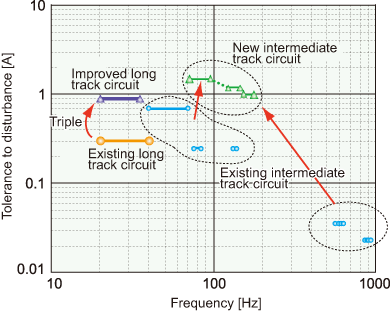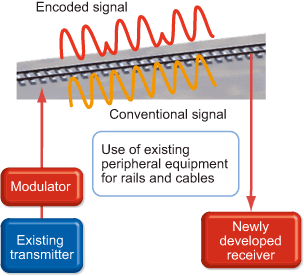14. Track circuit with higher permissible interference level
- The RTRI developed a new track circuit that has higher tolerance to interference and suited a broad range of section conditions.
- It also developed a method to increase tolerance to disturbance in long track circuits which only requires partial equipment replacement.
When new types of vehicle are developed, care is taken to ensure they do not generate currents exceeding the admissible level of interference specified for each kind of track circuit, to avoid circuit malfunctions. However, the existence of many types of track circuit with low permissible interference levels is one obstacle to such development. Accordingly, RTRI developed a new track circuit for intermediate sections between stations (called an intermediate track circuit) and an improved long track circuit (Fig. 1).
A wide variety of intermediate track circuit types are used between stations on conventional lines depending on section conditions. In order reduce this variety an intermediate track circuit was developed with a higher tolerance to disturbance than existing types. It can be applied to ordinary track circuits (i.e. most types except long track circuits) in intermediate sections between stations using an encoding system with a proven performance record in such applications as digital ATC. The developed circuit has the advantages of not requiring high-voltage distribution for signals and enabling information transmission corresponding to five kinds of signal aspect via the rails.
Long track circuits (a type of intermediate track circuit) are used in long and low transport density sections. However, their notably low tolerance to disturbance can give rise to serious problems. Given the difficulty in applying the newly developed intermediate track circuit to sections with long track circuits, a system was developed to increase the permissible interference level by simply adding a modulator and replacing the receiver. By adopting a system which sends a signal consisting of encoded output from the existing transmitter (Fig. 2) makes it possible to triple the level of tolerance to disturbance (Fig. 1), while making use of the existing transmitter, cables and field equipment.
Field tests performed using test equipment for both types of track circuit confirmed their ability to operate in the field.
 Fig. 1 Tolerance against disturbance in the developed intermediate track circuit
Fig. 1 Tolerance against disturbance in the developed intermediate track circuit Fig. 2 Configuration of the improved long track circuit
Fig. 2 Configuration of the improved long track circuit